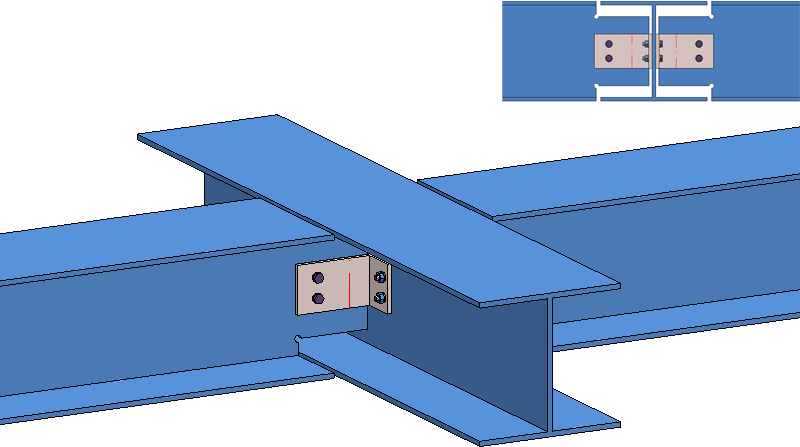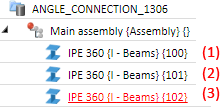
Angle connection, double-sided
Project: HiCAD Steel Engineering
"Civil Engineering functions" docking window > Steel Engineering > Connections > Front side to web/flange side > Angle connection, double-sided (1306)
Use this function to connect two beams by angle steels to a third beam. Each of the two angle connections can be user-defined or according to DAST. For DAST connections you can choose between
The function can be applied to parallel and perpendicular flanges.

Angle connection, double-sided
The dialogue window is largely operated in the same way as the Angle connection, one-sided (1305) dialogue window.
 Please note:
Please note:
A maximum of 6 Bolting groups are created for this angle connection. The assigning of these bolting sets depends on the settings on the Boltings tab.
It also depends on the settings on the Boltings tab how the angle connection will be inserted into the part structure. The table shown below is meant to illustrate this on the basis of the following drawing:

| 1st beam | 2nd beam | 3rd beam | Assignment | Structure |
|---|---|---|---|---|
|
Workshop |
Workshop |
Site |
Loose part |
The L-brackets are assigned to the assembly of the 1st or 2nd beam, respectively. The bolting groups are assigned to a separate structure assembly called Loose parts. |
|
Workshop |
Workshop |
Site |
Assembly |
The L-brackets and the boltings on the 1st and 2nd beam are assigned to the assembly of the 1st or 2nd beam, respectively. The boltings on the 3rd beam are assigned to a structure assembly with the name Loose parts located on the same level as the 3rd beam. |
|
Workshop |
Site |
Site |
Loose part |
The L-bracket on the 1st beam are assigned to the assembly of the 1st beam. The L-brackets on the 2nd beam and all bolting groups are assigned to a structure assembly called Loose parts. |
|
Workshop |
Site |
Site |
Assembly |
The L-brackets and boltings on the 1st beam and the boltings on the 3rd beam are assigned to the assembly of the 1st beam. The L-brackets and boltings on the 2nd beam are assigned to a structure assembly called Loose parts located on the same level as the 2nd beam. |
|
Site |
Workshop |
Site |
Loose part |
The L-beams on the 2nd beam are assigned to the assembly of the 2nd beam.The L-brackets on the 1st beam and all bolting groups are assigned to a structure assembly called Loose parts. |
|
Site |
Workshop |
Site |
Assembly |
The L-brackets and boltings on the 2nd beam and the boltings on the 3rd beam are assigned to the assembly of the 2nd beam. The L-brackets and boltings on the 1st beam are assigned to a structure assembly called Loose parts located on the same level as the 1st beam. |
|
Site |
Site |
Workshop |
Loose part |
All L-brackets are assigned to the assembly of the 3rd beam. All bolting groups are assigned to a structure assembly called Loose parts. |
|
Site |
Site |
Workshop |
Assembly |
The L-brackets and boltings on the 3rd beam are assigned to the assembly of the 3rd beam. The boltings on the 1st and 2nd beam are assigned to a structure assembly called Loose parts. |
|
Site |
Site |
Site |
- |
All L-brackets and all bolting groups are assigned to a structure assembly called den Loose Teile. |

Connections + Variants (3-D SE) •Dialogue Window for Connections - Type I (3-D SE) • The Catalogue System for Connections + Variants (3-D SE)
|
© Copyright 1994-2019, ISD Software und Systeme GmbH |